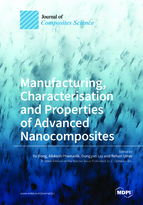Manufacturing, Characterisation and Properties of Advanced Nanocomposites
A special issue of Journal of Composites Science (ISSN 2504-477X). This special issue belongs to the section "Nanocomposites".
Deadline for manuscript submissions: closed (31 August 2018) | Viewed by 49802
Special Issue Editors
Interests: polymer nanocomposites; green composites and biocomposites; electrospun nanofibres/nanocomposites; composite characterisation and modelling; nanomaterials and nanofillers; additive manufacturing for composite materials
Interests: machining processes; CAD/CAM; digital manufacturing
Special Issues, Collections and Topics in MDPI journals
Interests: extraction of nanocellulose and its polymer composites; nanocellulose and graphene composites; manufacturing polymer/graphene nanocomposites; functional nanocomposites for oil/water separation, electrical and thermal conducting materials; natural polymers, electrospun nanofibers
Interests: composites manufacturing; liquid composite moulding; automated fiber placement; pultrusion; process modeling and control; graphene based composites and their manufacturing; natural fibre composites
Special Issue Information
Dear Colleagues,
In recent years, advanced nanocomposites have attracted a great deal of attention from materials engineers and industrialists due to numerous advantages, including the use of a small amount of nanofillers to significantly enhance the material properties of resulting nanocomposites, widespread applications in a range of fields, such as automobiles, aerospace and aerocrafts, building structures, biomedical devices, etc., as well as easy processibility based on current manufacturing technologies, such as melt compounding, solution casting, in situ polymerisation and electrospinning.
Advanced nanocomposites reinforced with carbon nanotubes (CNTs), graphene oxides (GOs), nanoclays, nanocellulose, and nanofibres demonstrate excellent multifunctional properties, consisting of better mechanical, thermal, electrical, and barrier properties. The key issue is still the encountered challenge of homogeneous filler dispersion in morphological structures for tailored advanced nanocomposites. Hence, processing-structure-property nanocomposite relationship is crucial for their future development as innovative hybrid material systems.
This Special Issue will address above-mentioned points in relation to manufacturing, characterisation, and properties of advanced nanocomposites to offer an insight into this new composite family with the incorporation of nanofillers, nanoparticles, and nanomaterials in order to eventually achieve the nanotechnological "bottom-up" scheme.
Dr. Yu Dong
Dr. Alokesh Pramanik
Assoc. Prof. Dongyan Liu
Dr. Rehan Umer
Guest Editors
Manuscript Submission Information
Manuscripts should be submitted online at www.mdpi.com by registering and logging in to this website. Once you are registered, click here to go to the submission form. Manuscripts can be submitted until the deadline. All submissions that pass pre-check are peer-reviewed. Accepted papers will be published continuously in the journal (as soon as accepted) and will be listed together on the special issue website. Research articles, review articles as well as short communications are invited. For planned papers, a title and short abstract (about 100 words) can be sent to the Editorial Office for announcement on this website.
Submitted manuscripts should not have been published previously, nor be under consideration for publication elsewhere (except conference proceedings papers). All manuscripts are thoroughly refereed through a single-blind peer-review process. A guide for authors and other relevant information for submission of manuscripts is available on the Instructions for Authors page. Journal of Composites Science is an international peer-reviewed open access monthly journal published by MDPI.
Please visit the Instructions for Authors page before submitting a manuscript. The Article Processing Charge (APC) for publication in this open access journal is 1800 CHF (Swiss Francs). Submitted papers should be well formatted and use good English. Authors may use MDPI's English editing service prior to publication or during author revisions.
Keywords
- nanocomposites
- nanofillers
- nanostructures
- filler dispersion
- morphological structures
- material properties
- experimental characterisation








